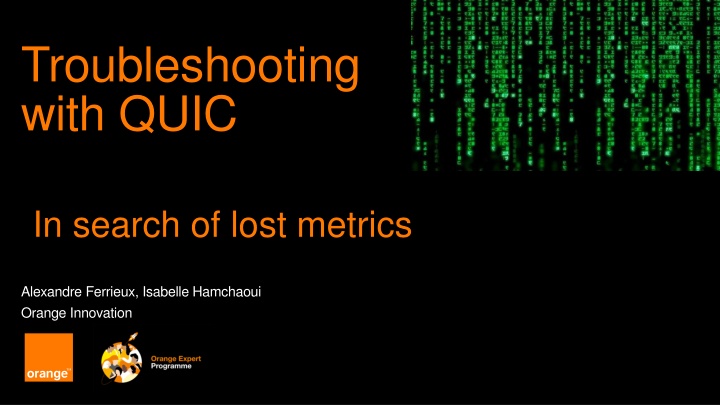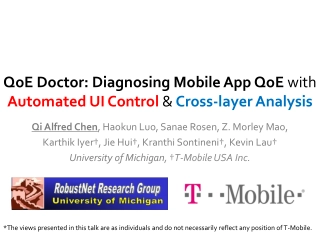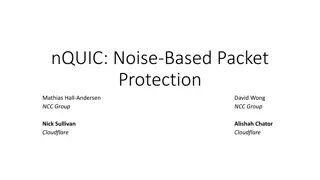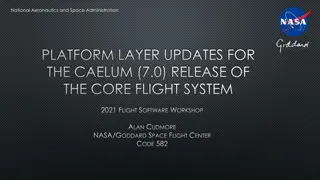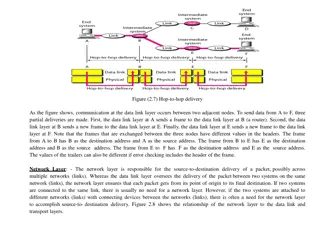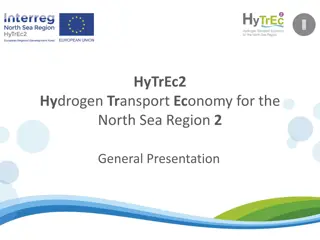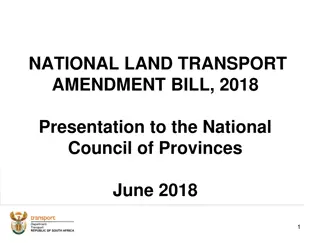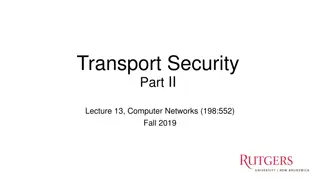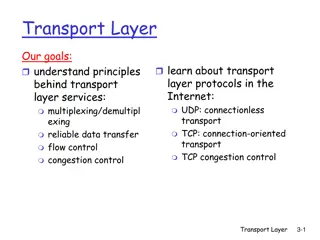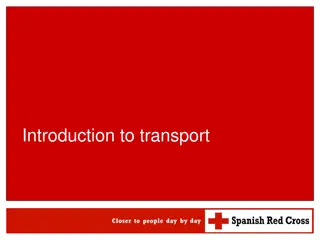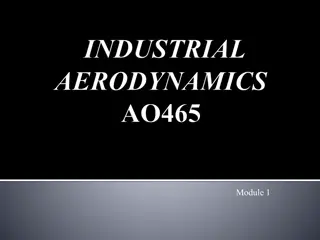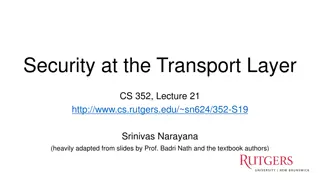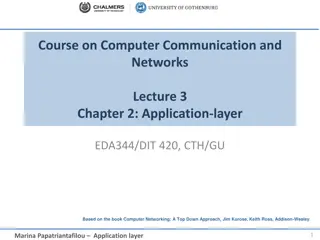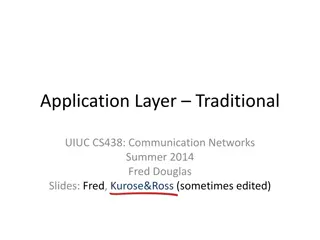QUIC: The Future of Transport Layer Protocols
QUIC is a revolutionary transport protocol developed by Orange Innovation to address issues faced by traditional TCP. It offers deep encryption, enhanced privacy, and resistance to ossification, enabling faster and more secure data transmission. By building over UDP and implementing encryption, QUIC challenges the status quo of TCP-based communication, paving the way for a more resilient and efficient internet infrastructure.
Download Presentation

Please find below an Image/Link to download the presentation.
The content on the website is provided AS IS for your information and personal use only. It may not be sold, licensed, or shared on other websites without obtaining consent from the author.If you encounter any issues during the download, it is possible that the publisher has removed the file from their server.
You are allowed to download the files provided on this website for personal or commercial use, subject to the condition that they are used lawfully. All files are the property of their respective owners.
The content on the website is provided AS IS for your information and personal use only. It may not be sold, licensed, or shared on other websites without obtaining consent from the author.
E N D
Presentation Transcript
Troubleshooting with QUIC In search of lost metrics Alexandre Ferrieux, Isabelle Hamchaoui Orange Innovation
What is QUIC ? 30%of Orange traffic Start in 2014, IETF standard in 2021 A transport protocol similar to advanced TCP versions with deep encryption to avoid ossification HTTP/3 Child of the NSA scandal : Enhanced privacy, no linkability! Standard Transport Layer QUIC
Layer 4 in theory The transport layer End-to-end connectivity TCP, UDP Data #9 #8 #6 HTTP Layer 5+ HTTP TCP Layer 4 TCP Error control (TCP) IP IP Layer 3 IP Flow control (TCP) Ack #4 #2
Reality check TCP transport layer Middleboxes interfere illegitimately in the Transport Layer Proxy, optimizer, etc. Data #9 #8 #6 Layer 5+ HTTP HTTP Middleboxes far behind standards Layer 4 TCP TCP TCP New Transport protocols blocked Layer 3 IP IP IP New TCP mechanisms blocked : e.g. TCP fast open Ack #4 #2 Ossification of the Internet, innovation blocked for decades
QUIC is an answer TCP-like transport built over UDP + encryption Data #9 #8 #6 HTTP/2 HTTP/2 TLS TLS TCP TCP IP IP Ack #4 #2 Ossification-ender Middleboxes interference made difficult by QUIC headers encryption
QUIC is an answer TCP-like transport built over UDP + encryption Data #9 #8 #6 HTTP/3 HTTP/2 HTTP/2 HTTP/3 TLS QUIC TLS QUIC TCP TCP UDP IP UDP IP IP IP Ack #4 #2 Ossification-ender Middleboxes interference made difficult by QUIC headers encryption
QUIC is an answer TCP-like transport built over UDP + encryption Data #9 #8 #6 HTTP/3 HTTP/2 HTTP/2 HTTP/3 TLS QUIC TLS QUIC TCP TCP UDP IP UDP IP IP IP Ack #4 #2 Ossification-ender Middleboxes interference made difficult by QUIC headers encryption
TCP one point passive measurement 689 #8 #9 #8 #6 Data Losses 421 #4 #2 Ack #8 Upstream and downstream loss (+ delay) Location of the faulty segment / actor TCP
What else then? Packet drop counters? IP loss counters ? ? QUIC Poor and cumbersome diagnosis Counters not available in all nodes => no exhaustivity No upstream/downstream loss: where is the faulty segment / actor?
2-points measurements? Access Provider lead ? ? ? ? ? ? No end-to-end degradation detection AP needs simultaneous captures from various (trusted?) actors Capture in customer OS? QUIC Content Provider lead ? ? ? ? ? ? ? ? ? ? End-to-end degradation detection CP needs simultaneous captures from various (trusted?) actors Should we perform captures on behalf of Google? Facebook? Bullshit.com? QUIC
Active measurement ? ? ? ? ? ? Representativity (UE/server configuration, multipath) For specific investigations only QUIC
Key disclosure The dream solution! Key disclosure by client or server Awesome! Back to TCP debug Any chance to get it? QUIC
The Loss bits mechanism What? Detect and locate faulty segments without packet number How? Reference patterns drawn in the packet flows with 2 bits in clear in the QUIC header
The loss bits proposal (1) Upstream Loss N packets Upstream Loss exposed via 1 bit in clear Our proposal
The loss bits proposal (2) Upstream Loss End-to-end Loss End-to-end Loss exposed via 1 bit in clear Our proposal
The Loss Bits in the wild Field Trial with Akamai in 4 Orange affiliates Akamai CDN servers with loss bits implementation Thousands of Orange real clients Loss bits mechanism refined and validated Acces network Core network Internet Additional validation by Satcom on Akamai servers and a satellite link
Wrap-up Current Troubleshooting practices are threatened In case of bad customer experience with QUIC, no easy way to locate faulty segment and prove actors responsibility New balance of power within the IETF arena Strong support from Akamai and CDN providers Very few operators expressed interest : Satcom, Telecom Italia Lukewarm support from Google, Microsoft, Apple Fierce opposition from Facebook and Mozilla Wait Is loss still critical? BBR is quite robust to mild loss Other Loss sensitive services ? Our mechanism is ultra light, energy efficienty, and still useful for strong loss
References First draft presented at IETF 104 (March 2019) https://datatracker.ietf.org/doc/draft-ferrieuxhamchaoui-quic-lossbits Orange-Akamai trial presented at IETF 105 (July 2019) https://datatracker.ietf.org/meeting/105/materials/slides-105-maprg-packet-loss-signaling- for-encrypted-protocols-01 Akamai+lightspeed step-in at IETF 106 (November 2019) https://datatracker.ietf.org/doc/draft-ferrieuxhamchaoui-tsvwg-lossbits/ Satcom trial presented at IETF 106 (November 2019) https://datatracker.ietf.org/meeting/106/materials/slides-106-maprg-losses-in-satcom- systems-identification-and-impact Joint draft with Telecom Italia (mars 2020) https://datatracker.ietf.org/doc/draft-mdt-ippm-explicit-flow-measurements/ Independent evaluation from Ike Kunze et al. (Aachen university) L, Q, R, and T: which spin bit cousin is here to stay? (ANRW '21)
